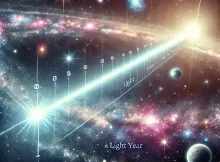
When we think of distances on Earth, we often use miles or kilometers. But when it comes to the cosmos, these units become practically meaningless. Imagine trying to measure the distance to the nearest star in miles—it would require a number with so many zeroes that it becomes impossible to comprehend. That’s where the term light-year comes in. But what exactly is a light-year, and why is it so useful for astronomers?
- A light year is a measure of distance similar to a mile or a kilometer.
- A light year is the distance that light can travel in a year.
- One light-year is equal to 9,500,000,000,000 kilometers
So how far is that?
Light can travel around the earth 7 times in one second. That distance would be a light second since that is how far light can travel in a second. Since there are 60 seconds in a minute you multiply that distance by 60 and you have a light minute. That means light can circle the earth 420 times in one minute! Multiply by 60 to get a light hour. Multiply by 24 to get a light day (how far light can travel in a day). Multiply that by 365 and you get a light year which is the distance light can travel in a year.
The moon which is about 1.25 light seconds away from the earth. That is about the same distance as going 9 times around the earth. If you turned on a bright light on the moon it would take 1.25 seconds to reach the earth.
The distance light can travel in 60 seconds is a light minute. It takes light 8 minutes to travel from the sun to the earth, so the sun is 8 light minutes away. Another term for the distance from the earth to the sun is an Astronomical Unit (AU). That distance is like traveling around the earth 3360 times (7x60x8).
It takes light from the sun 340 minutes (5.7 hours) to travel from the sun to Pluto. That is equivalent to 39.5 AU. While that is only 5.7 light hours, if you travel at 100 km/hr it would take 60,000,000 hrs, which is 6849.3 years to reach pluto!
So now imagine how far light can travel in a year! At 100 km/hr it would take you 10,526,292 years to travel one light year!
Why Use Light-Years?
In the vastness of space, using traditional distance units would quickly lead to unwieldy numbers. For instance, the distance from the Earth to the Sun is about 93 million miles (150 million kilometers). While that’s quite a distance by earthly standards, it’s only about 8.3 light-minutes away. That’s right—light takes just over 8 minutes to travel from the Sun to Earth.
By using light-years, astronomers can express distances in more comprehensible units. For example:
- The nearest galaxy, the Andromeda Galaxy, is 2.5 million light-years away.
- The Milky Way galaxy is roughly 100,000 light-years across.
- The observable universe is around 93 billion light-years in diameter.
Real-World Comparisons
It’s hard to grasp just how far a light-year is because our brains are accustomed to thinking in miles or kilometers. To put it in perspective:
- If you could travel at the speed of light, you would circle the Earth 7.5 times in one second.
- Driving a car at 60 miles per hour (about 100 kilometers per hour), it would take more than 11 million years to complete a single light-year journey.
- Even the fastest spacecraft ever built, NASA’s Parker Solar Probe, traveling at a top speed of 430,000 miles per hour (700,000 kilometers per hour), would take over 17,000 years to travel just one light-year!
Some Distances in Light Years
- The star that is nearest to our sun is Proxima Centauri which is 4.2 light years away.
- There are only eleven stars that are less then 10 light years away.
- Our galaxy, the Milky Way, is about 100,000 light years across.
- The closest galaxy to the Milky Way, Andromeda, is 2,500,000 light years away.
- The most distant galaxy discovered is 12,800,000,000 light years away.
- Who knows what is beyone that?
The concept of a light-year goes beyond mere distance. It represents the speed of light’s incredible journey across the cosmos, linking space and time in a profound way. It allows us to map the universe, understand its history, and marvel at its scale. So, next time you hear a star or galaxy described in light-years, remember: you’re not just learning how far away it is—you’re also learning how far back in time you’re looking.
